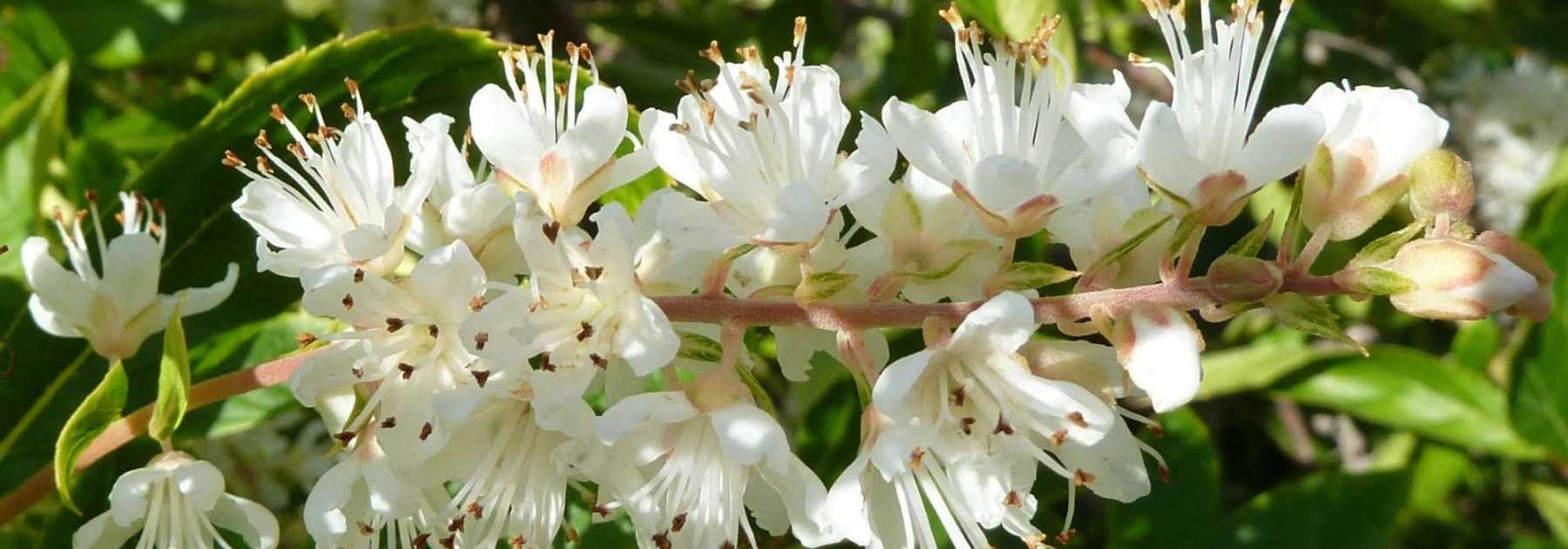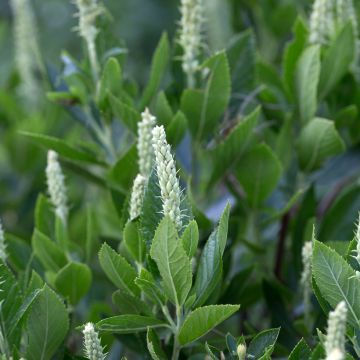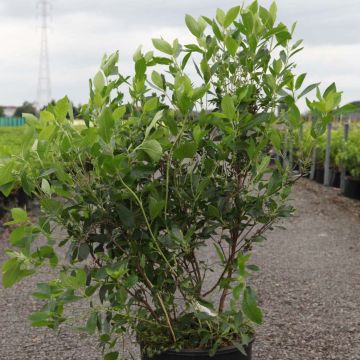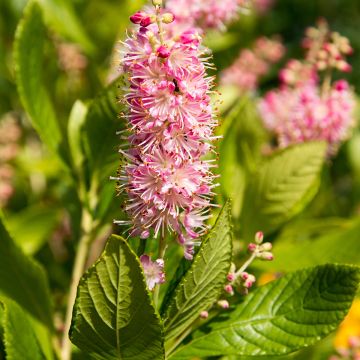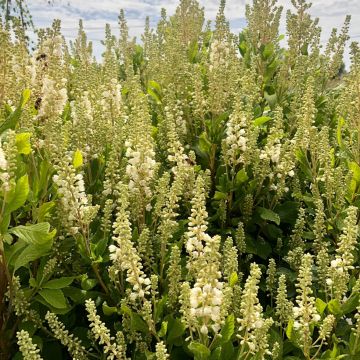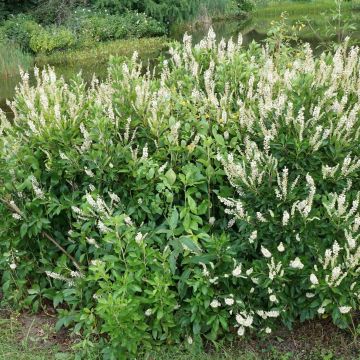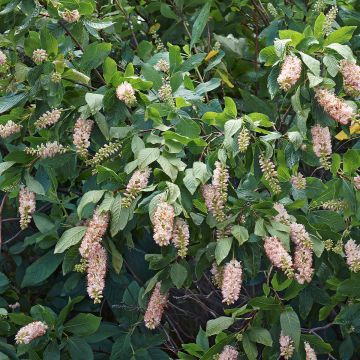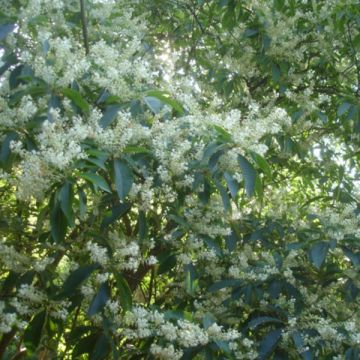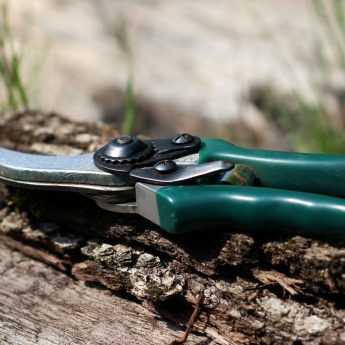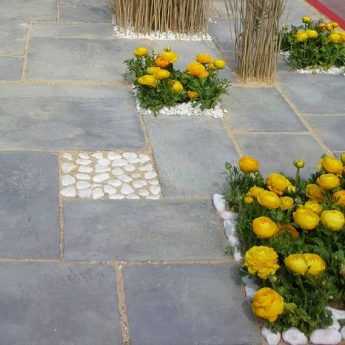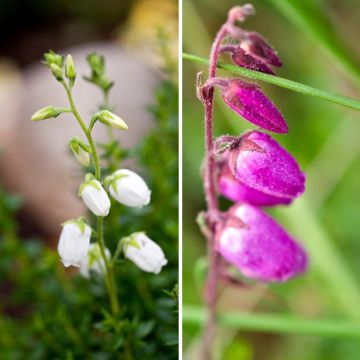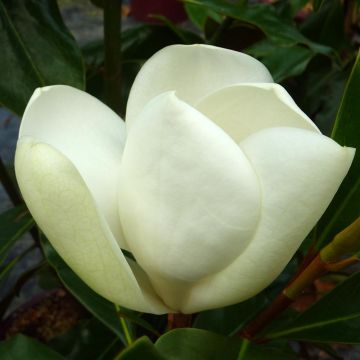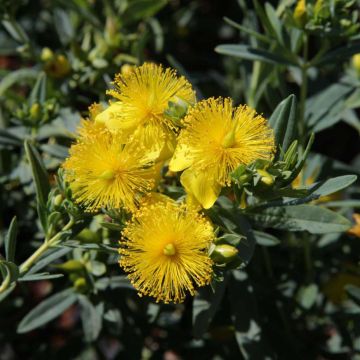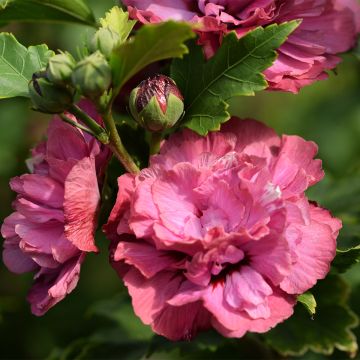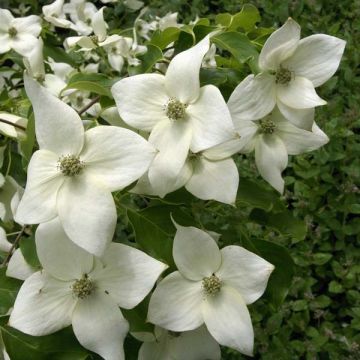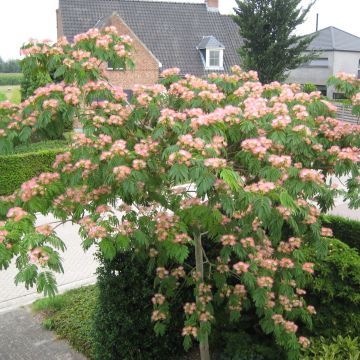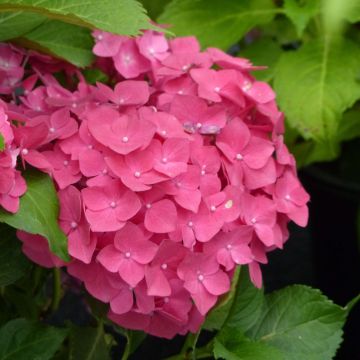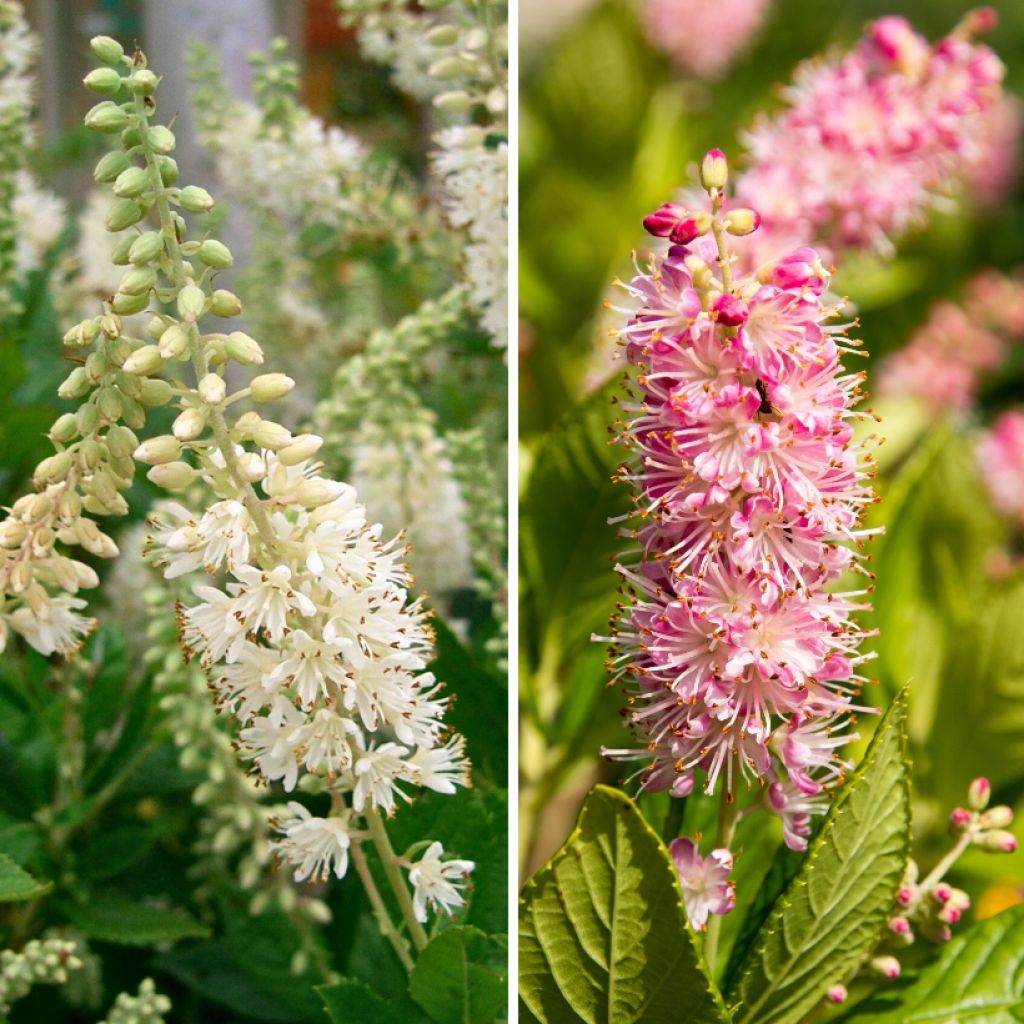

Clethra Duo
Clethra Duo
Clethra alnifolia sp., Ruby Spice
Summer Sweet, Sweet Pepperbush, Coastal Sweet Pepperbush
Home or relay delivery (depending on size and destination)
Schedule delivery date,
and select date in basket
This plant carries a 24 months recovery warranty
More information
We guarantee the quality of our plants for a full growing cycle, and will replace at our expense any plant that fails to recover under normal climatic and planting conditions.
Does this plant fit my garden?
Set up your Plantfit profile →
Collection items (0 plants)
Description
This Clethra duo enhances a large ericaceous area or the base of large deciduous trees in the undergrowth in cool and acidic soil. It combines two varieties of a deciduous bush with a bushy habit and suckering stump, which flowers in September-October. Their flowering forms 8 to 15-cm clusters composed of small fluffy and highly fragrant flowers, white or pink, depending on the plant. Their foliage turns golden yellow in autumn before falling. Hardy to at least -20 °C, they also adapt to container cultivation, like camellias and rhododendrons.
It consists of:
1 Clethra alnifolia: native to the undergrowth of the eastern United States, this bush reaches about 2 m in all directions. Its flowering is pure white.
1 Clethra alnifolia 'Ruby Spice': This compact variety reaches about 1 m in all directions and offers distinctly pink flowers, unlike the white flowers of the species.
With its bushy silhouette and fragrant spike-like flowering, Clethra brings a touch of exoticism to cool and slightly shaded areas of the garden, often lacking in flowers at the end of summer. Its autumn foliage in shades of brown enlivens the undergrowth at the end of the season. The Clethras in this duo appreciate the same conditions as rhododendrons and autumn camellias, with which they form beautiful combinations. Plant them in partial shade, humus-bearing, non-limestone soil that remains slightly moist in summer. Mulch, if necessary, in summer to save on watering and maintain freshness. Place the smaller 'Ruby Spice' variety before the white-flowered species. Maintain a spacing of 1.50 m between the two Clethras or between different bushes in your bed.
Pot cultivation: if you have alkaline soil, these heathland shrubs are ideal. Choose a pot 2 to 4 times larger than the size of your root ball. The pot should have drainage holes at the bottom. Place clay pebbles at the bottom of the pot. Position your root ball so that the bush collar is level with the soil's surface. Fill the pot with 1/3 ericaceous soil, 1/3 compost, and 1/3 garden soil. Place your pot in shade or partial shade. A few hours of sunlight per day is sufficient.
Plant habit
Flowering
Foliage
Botanical data
Clethra
alnifolia
sp., Ruby Spice
Clethraceae
Summer Sweet, Sweet Pepperbush, Coastal Sweet Pepperbush
Clethra tomentosa
North America
Other Clethra
View all →Planting and care
Clethra alnifolia, hardy down to a minimum of -20°C, is preferably planted in spring in soil that remains moist all year round, light, well-drained, acidic and semi-shaded. Adding turf when planting is recommended to acidify the soil. Growing in pure ericaceous soil is also accepted. This bush cannot tolerate limestone or drought. Remove faded flowers and, in winter, prune old stems. It is naturally resistant to diseases and parasites.
Planting period
Intended location
Care
Planting & care advice
This item has not been reviewed yet - be the first to leave a review about it.
Similar products
Haven't found what you were looking for?
Hardiness is the lowest winter temperature a plant can endure without suffering serious damage or even dying. However, hardiness is affected by location (a sheltered area, such as a patio), protection (winter cover) and soil type (hardiness is improved by well-drained soil).
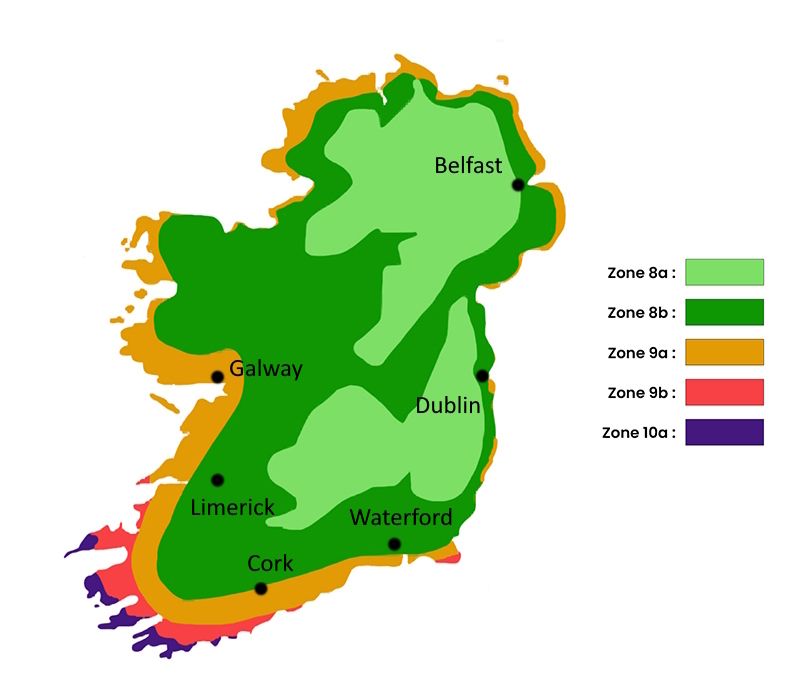
Photo Sharing Terms & Conditions
In order to encourage gardeners to interact and share their experiences, Promesse de fleurs offers various media enabling content to be uploaded onto its Site - in particular via the ‘Photo sharing’ module.
The User agrees to refrain from:
- Posting any content that is illegal, prejudicial, insulting, racist, inciteful to hatred, revisionist, contrary to public decency, that infringes on privacy or on the privacy rights of third parties, in particular the publicity rights of persons and goods, intellectual property rights, or the right to privacy.
- Submitting content on behalf of a third party;
- Impersonate the identity of a third party and/or publish any personal information about a third party;
In general, the User undertakes to refrain from any unethical behaviour.
All Content (in particular text, comments, files, images, photos, videos, creative works, etc.), which may be subject to property or intellectual property rights, image or other private rights, shall remain the property of the User, subject to the limited rights granted by the terms of the licence granted by Promesse de fleurs as stated below. Users are at liberty to publish or not to publish such Content on the Site, notably via the ‘Photo Sharing’ facility, and accept that this Content shall be made public and freely accessible, notably on the Internet.
Users further acknowledge, undertake to have ,and guarantee that they hold all necessary rights and permissions to publish such material on the Site, in particular with regard to the legislation in force pertaining to any privacy, property, intellectual property, image, or contractual rights, or rights of any other nature. By publishing such Content on the Site, Users acknowledge accepting full liability as publishers of the Content within the meaning of the law, and grant Promesse de fleurs, free of charge, an inclusive, worldwide licence for the said Content for the entire duration of its publication, including all reproduction, representation, up/downloading, displaying, performing, transmission, and storage rights.
Users also grant permission for their name to be linked to the Content and accept that this link may not always be made available.
By engaging in posting material, Users consent to their Content becoming automatically accessible on the Internet, in particular on other sites and/or blogs and/or web pages of the Promesse de fleurs site, including in particular social pages and the Promesse de fleurs catalogue.
Users may secure the removal of entrusted content free of charge by issuing a simple request via our contact form.
The flowering period indicated on our website applies to countries and regions located in USDA zone 8 (France, the United Kingdom, Ireland, the Netherlands, etc.)
It will vary according to where you live:
- In zones 9 to 10 (Italy, Spain, Greece, etc.), flowering will occur about 2 to 4 weeks earlier.
- In zones 6 to 7 (Germany, Poland, Slovenia, and lower mountainous regions), flowering will be delayed by 2 to 3 weeks.
- In zone 5 (Central Europe, Scandinavia), blooming will be delayed by 3 to 5 weeks.
In temperate climates, pruning of spring-flowering shrubs (forsythia, spireas, etc.) should be done just after flowering.
Pruning of summer-flowering shrubs (Indian Lilac, Perovskia, etc.) can be done in winter or spring.
In cold regions as well as with frost-sensitive plants, avoid pruning too early when severe frosts may still occur.
The planting period indicated on our website applies to countries and regions located in USDA zone 8 (France, United Kingdom, Ireland, Netherlands).
It will vary according to where you live:
- In Mediterranean zones (Marseille, Madrid, Milan, etc.), autumn and winter are the best planting periods.
- In continental zones (Strasbourg, Munich, Vienna, etc.), delay planting by 2 to 3 weeks in spring and bring it forward by 2 to 4 weeks in autumn.
- In mountainous regions (the Alps, Pyrenees, Carpathians, etc.), it is best to plant in late spring (May-June) or late summer (August-September).
The harvesting period indicated on our website applies to countries and regions in USDA zone 8 (France, England, Ireland, the Netherlands).
In colder areas (Scandinavia, Poland, Austria...) fruit and vegetable harvests are likely to be delayed by 3-4 weeks.
In warmer areas (Italy, Spain, Greece, etc.), harvesting will probably take place earlier, depending on weather conditions.
The sowing periods indicated on our website apply to countries and regions within USDA Zone 8 (France, UK, Ireland, Netherlands).
In colder areas (Scandinavia, Poland, Austria...), delay any outdoor sowing by 3-4 weeks, or sow under glass.
In warmer climes (Italy, Spain, Greece, etc.), bring outdoor sowing forward by a few weeks.


































